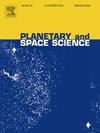旋转小行星陨石坑表面充注的三维模拟
IF 1.7
4区 物理与天体物理
Q3 ASTRONOMY & ASTROPHYSICS
引用次数: 0
摘要
小行星表面的陨石坑阻碍了太阳风的水平流动,形成了等离子体尾流,调节了粒子通量和远下游的静电环境。本研究基于神经网络和有限元方法,对具有非平凡地形的小行星表面电荷特性进行了模拟。关键因素,如位置,大小和深宽比的陨石坑都考虑在内。在正常情况下,随着陨石坑纬度的增加,其底部在旋转过程中的电位变化逐渐变得平缓,最终稳定在−27.5 V左右,当陨石坑接近两极时波动较小。由于电子的发散运动和离子的较少偏转轨迹,在终结点附近,低深宽比陨石坑内的表面电位变化主要取决于离子密度,离子密度随深度的增加而减小。相比之下,对于深宽比大于0.5的陨石坑,坑底电位差主要来自于电子分布。表面电位与陨石坑大小的变化无关,只有在太阳风暴期间,大型陨石坑的底部,如直径为800 m的陨石坑,与直径为50 m的小陨石坑相比,电位下降26.78 V。局部等离子体流场和小行星表面充电现象的研究对未来的安全着陆和探测任务具有重要影响。本文章由计算机程序翻译,如有差异,请以英文原文为准。
Three-dimensional simulation of surface charging in meteorite craters on rotating asteroids
Meteorite craters on the asteroid surface obstruct the horizontal flow of solar wind, forming a plasma wake that modulates the particle fluxes and the electrostatic environment far downstream. In this study, the surface charging properties of asteroids with nontrivial terrain are simulated on the basis of the neural network and the finite element method. Key factors such as the location, size and depth-to-width ratio of craters are all considered. Under normal conditions, as the latitude of the crater increases, the potential variation at its floor during a rotation gradually becomes smoother, finally stabilizing around −27.5 V with minor fluctuations when the crater approaches the poles. Because of the diverging motions of electrons and the less deflected trajectories of ions, near the terminator, the surface potential variation within craters with low depth-to-width ratios primarily depends on ion density, which decreases with increasing depth. In contrast, for craters with a depth-to-width ratio greater than 0.5, the potential differences at the crater floor arise mainly from the electron distribution. While the surface potential appears indifferent to changes in crater size, only during solar storms, the floor of large-scale craters, such as those with a diameter of 800 m, perform a 26.78 V decrease in potential compared to small craters of 50 m. Both studies of localized plasma flow field and the surface charging phenomenon of asteroids have substantial influence on the future safe landing and exploration missions.
求助全文
通过发布文献求助,成功后即可免费获取论文全文。
去求助
来源期刊

Planetary and Space Science
地学天文-天文与天体物理
CiteScore
5.40
自引率
4.20%
发文量
126
审稿时长
15 weeks
期刊介绍:
Planetary and Space Science publishes original articles as well as short communications (letters). Ground-based and space-borne instrumentation and laboratory simulation of solar system processes are included. The following fields of planetary and solar system research are covered:
• Celestial mechanics, including dynamical evolution of the solar system, gravitational captures and resonances, relativistic effects, tracking and dynamics
• Cosmochemistry and origin, including all aspects of the formation and initial physical and chemical evolution of the solar system
• Terrestrial planets and satellites, including the physics of the interiors, geology and morphology of the surfaces, tectonics, mineralogy and dating
• Outer planets and satellites, including formation and evolution, remote sensing at all wavelengths and in situ measurements
• Planetary atmospheres, including formation and evolution, circulation and meteorology, boundary layers, remote sensing and laboratory simulation
• Planetary magnetospheres and ionospheres, including origin of magnetic fields, magnetospheric plasma and radiation belts, and their interaction with the sun, the solar wind and satellites
• Small bodies, dust and rings, including asteroids, comets and zodiacal light and their interaction with the solar radiation and the solar wind
• Exobiology, including origin of life, detection of planetary ecosystems and pre-biological phenomena in the solar system and laboratory simulations
• Extrasolar systems, including the detection and/or the detectability of exoplanets and planetary systems, their formation and evolution, the physical and chemical properties of the exoplanets
• History of planetary and space research
 求助内容:
求助内容: 应助结果提醒方式:
应助结果提醒方式:


